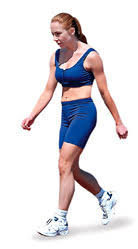Engage your arms!
Make a loose fist, consciously swing your arms, bringing your fist up to the approximate level of your breast bone, and then back to the outside of the hip. Pretend you are trying to move your arms against a force to engage the muscles even more when you walk.
Notice the posture of President Bush – Shoulders back, arms active, stomach in, head forward. Now compare to the gentleman next to him. Who do you think is getting more from their walk?

Forward head, not engaging arms or stomach, rounded shoulders.
I show this to make you think about your posture while on a treadmill. Fast walkers on a treadmill who hang on to the bar often have a sway back posture. Slow walkers often lean way forward – I call it the pushing the lawnmower posture. While on the treadmill, try to either not hold on and swing your arms, or hold on with only one arm. This will help you to have a better posture. When you hold on to the rails the entire time, your upper body is stiff and doesn’t move naturally as it does with your regular walking.
Also don’t look down the whole time this leads to forward head or thoracic kyphosis postures. Try to look 15-20 feet ahead of you. Hold your head high. Try to keep your chin parallel to the floor. Squeeze those shoulder blades together and down…this is the military posture or the busty look, tall and proud.
Some people are so stiff with walking, add a little wiggle to your walk allow your shoulders and hips to move naturally, this is very good for your spine. Being stiff and rigid isn’t helpful. Often after open heart surgery people are very stiff in the shoulders and neck. Again swinging the arms helps this.
Tighten your stomach muscles. These support your back, they provide you with core strength. If the belly sags forward it places more stress on your lumbar spine. Tuck your pelvis under your torso.
If your have back issues or balance issues I recommend walking with ski poles. They help you to stand taller, force you to engage your arms with the walk, and you burn more calories on your walk.
Compared to regular walking, ski walking involves applying force to the poles with each stride. Walking with ski poles uses more of their entire body (with greater intensity) and receive fitness building stimulation not present in normal walking for the chest, lats, triceps, biceps, shoulder, abdominals, spinal and other core muscles. This can produce up to a 46% increase in energy consumption compared to walking without poles. It also has been demonstrated to increase upper body muscle endurance by 38% in just twelve weeks.
This extra muscle involvement may lead to enhancements over ordinary walking at equal paces such as:
- increased overall strength and endurance in the core muscles and the entire upper body
- significant increases in heart rate at a given pace
- increasing vascular pathways and oxygen delivery efficiency
- greater ease in climbing hills
- burning more calories than in plain walking
- improved balance and stability with use of the poles
- significant un-weighting of hip, knee and ankle joints
- provides density preserving stress to bones
What about walking with weights?
If you want to walk with weights don’t use more than 1-2 lbs in your hands. Heavier weights tend to stress the neck and spine and are not recommended. Again don’t just hold the weights pump those arms, swing up to breast bone and back to hip. You engage the arms, you burn more calories.









